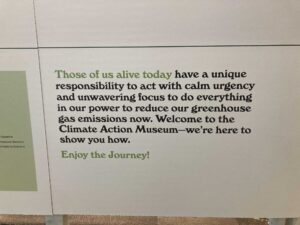Climate activists argue that our generations will be the last with a chance to slow climate change before it transforms into a climate disaster.
That’s a lot of pressure.
This pressure is something that many young people say causes stress. Who holds the responsibility for creating change?
Climate activists represent one of the most diverse communities of advocates, united by an issue that transcends political parties, religions, cultures, and languages. People worldwide are committed to finding ways to mitigate climate disasters and make solutions accessible and commonplace within their communities. Climate activists come in many forms, including students, parents, business owners, librarians, educators, and even presidents.
Diversity within the climate activist movement is so vast because climate change affects everyone and everything. Like many public health concerns, a large portion of those advocating for change are those most directly affected by the climate crisis. Voices are raised from under-resourced communities, demanding equity.
While most individuals are aware of the risks associated with climate change, and many have witnessed its effects in their neighborhoods, the plethora of solutions available remain less understood. Experts have identified actions that anyone can undertake to mitigate the impacts of climate change. The primary challenge lies in educating and sharing solutions with such a diverse, widespread group of change-makers.
As a communicator of impact and a climate activist, I was thrilled to stumble upon the Climate Action Museum in Chicago. The museum successfully conveys its message to one of the most diverse cities in the country. It also highlights a second challenge for climate activists: making the issue relevant to all individuals and inspiring collaboration across diverse communities.
During a recent trip to my former hometown of Chicago, I explored museums near downtown when the Climate Action Museum caught my eye on Maps.
The Climate Action Museum is an installation housed within a 23-story office building in Chicago’s South Loop. At first glance, it appeared to be an elegant pop-up installation. I imagined a trendy and photogenic interior within the stylish walls. However, what I encountered was far more captivating, impactful, and wholly unique.

The Climate Action Museum is a unique gallery of educational displays explaining the issue of global warming and highlighting potential solutions. According to the founders, its mission is to “activate a tipping point on climate mitigation in the Chicago region through education, stimulating critical thought, and to inspire and facilitate direct action.”
What the museum did right:
1. The Climate Action Museum understands the pivotal role museums play in driving societal change. It has a keen awareness of its audience—a vibrant community that includes international tourists, all-American students, and devoted Chicagoans. Display boards encircle the space, narrating the tale of how climate change affects those living in cities and rural areas.
It emphasizes various behaviors prevalent in rural and urban communities and dissects the impact of these behaviors on climate change. It doesn’t stop at explaining the issue. It provokes thought and presents solutions. For instance, one display outlines how individual driving habits impact carbon emissions and illustrates how public transportation can mitigate these emissions.
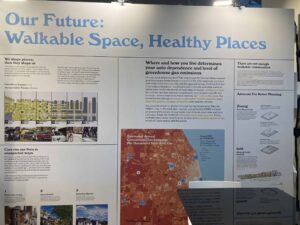
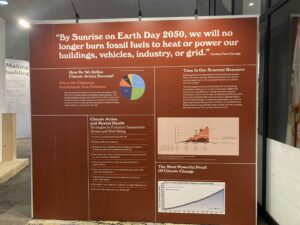
This messaging inspires visitors by showcasing the effectiveness of different solutions. Recognizing that public transportation isn’t universally accessible, the museum addresses this challenge. It encourages visitors to advocate for more walkable cities and prompts them to contemplate the benefits of increased transportation options in their hometowns. For anybody who isn’t familiar with the process of advocating for issues to local leaders, the museum breaks it down and gives a few steps toward contacting the right person and telling them about the community’s needs.
2. The museum sets actionable goals. As one of the initial display boards states, most people are aware of climate change. However, the options and scientific jargon surrounding the issue can be overwhelming. Some may feel that climate change is a predicament only politicians can resolve or that the available solutions need to be more flexible for their busy lifestyles.
Another hurdle for climate activists is establishing a common baseline of understanding among diverse groups about what climate change entails and how everyone can contribute to slowing global warming. To align every visitor’s perspective, the Climate Action Museum defines the issue and outlines its definition of success: eliminating greenhouse gas emissions. From that point on, solutions are interwoven throughout the exhibits.
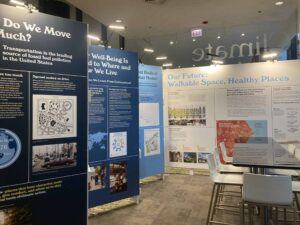
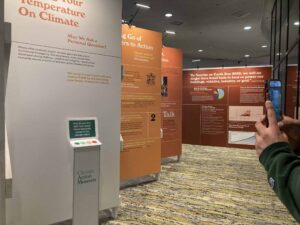
The museum presents actionable goals that individuals can work toward, such as establishing urban gardens, refraining from tilling soil on farms, or opting for public transport instead of driving. Additionally, it highlights numerous actions that are more accessible, like reducing meat consumption, minimizing travel, and sharing knowledge within one’s community. My takeaway was that our chances of combatting this climate change are much stronger when we rely on our community as a team. Our collaboration in changing lifestyle norms is one of the most powerful tools that we have.
The museum’s challenge was to make content relevant and compelling to each visitor, regardless of their cultural background, socioeconomic status, or abilities. The extensive range of options presented by the Climate Action Museum is inclusive, encompassing everyone, including individuals with unique abilities to set policies, business owners, political leaders, and other influential figures. The museum also engages Chicago residents, guiding them on how to advocate for environmentally friendly aspects when observing new construction developments, or when selecting their college majors, or when deciding how to spend their leisure time.
3. The exhibit concludes on an optimistic note. Upon entering, the Climate Action Museum presents visitors with a thought-provoking question: “What are your sentiments about climate change?” It offers range of emoji faces, extending from cheerful to glum. I opted for the moderate frowny face, acknowledging the presence of potential solutions, though I maintained reservations about their widespread adoption.
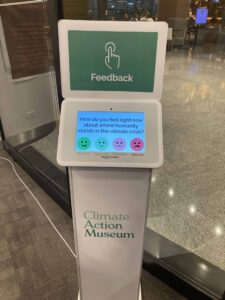 As I navigated the museum, delving into the array of solutions and opportunities at micro and macro levels, a newfound sense of hope began to dawn on me concerning the issue. Gradually, I became more optimistic about the possibility of witnessing similar museums and initiatives across the globe. I wished that I could have had another hour to go through the museum again and reread each poster.
As I navigated the museum, delving into the array of solutions and opportunities at micro and macro levels, a newfound sense of hope began to dawn on me concerning the issue. Gradually, I became more optimistic about the possibility of witnessing similar museums and initiatives across the globe. I wished that I could have had another hour to go through the museum again and reread each poster.
Instead, I reluctantly sought out the exit (I had to catch a flight back to Denver). The signage guiding visitors towards a “better world” left me in a hopeful state of awe.

Among the many captivating displays, a highlight was the museum’s final room. Paper posters adorned the walls, tailored to address each visitor based on their distinct roles within their communities: parents tending to young children, cycling enthusiasts, renters or homeowners, passing tourists, locals hailing from Chicago, and even the governor of Illinois.

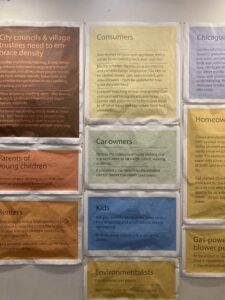
These posters underscored an overarching truth: each has a unique role in this ongoing struggle. The Climate Action Museum masterfully succeeded in leaving its visitors imbued with a renewed sense of optimism and a realization of their tangible contributions. As I engaged with the climate fear temperature checker on my way out, complete with a spectrum of emoji faces, a sense of relief swept over me as I confidently selected the happiest smiley face.
If you’d like to learn more about the Climate Action Museum, you can check out their website at www.climateactionmuseum.org or visit them in person at 300 S. Riverside Plaza, Chicago.

About the Author:
Graciella Saucedo-Rivera (she/her) is a natural challenger who lives for empowering people-powered communities. Through her work, she aims to build the capacity of individuals on the grassroots level. Honoring her lived experience growing up multicultural in a colorful immigrant community in St. Paul, Minnesota, she holds space to celebrate diverse cultures, faiths, and languages. She recently graduated from DePaul University in Chicago, IL with a B.S. in Business Marketing and a beloved minor in Theology. As an organizer, Gracie loves bringing together people to exchange ideas, build momentum, and create change. Gracie is at her best when she has her hands in the garden dirt, is feeding her family, cruising on her bike, or is alongside her elders in conversation.

